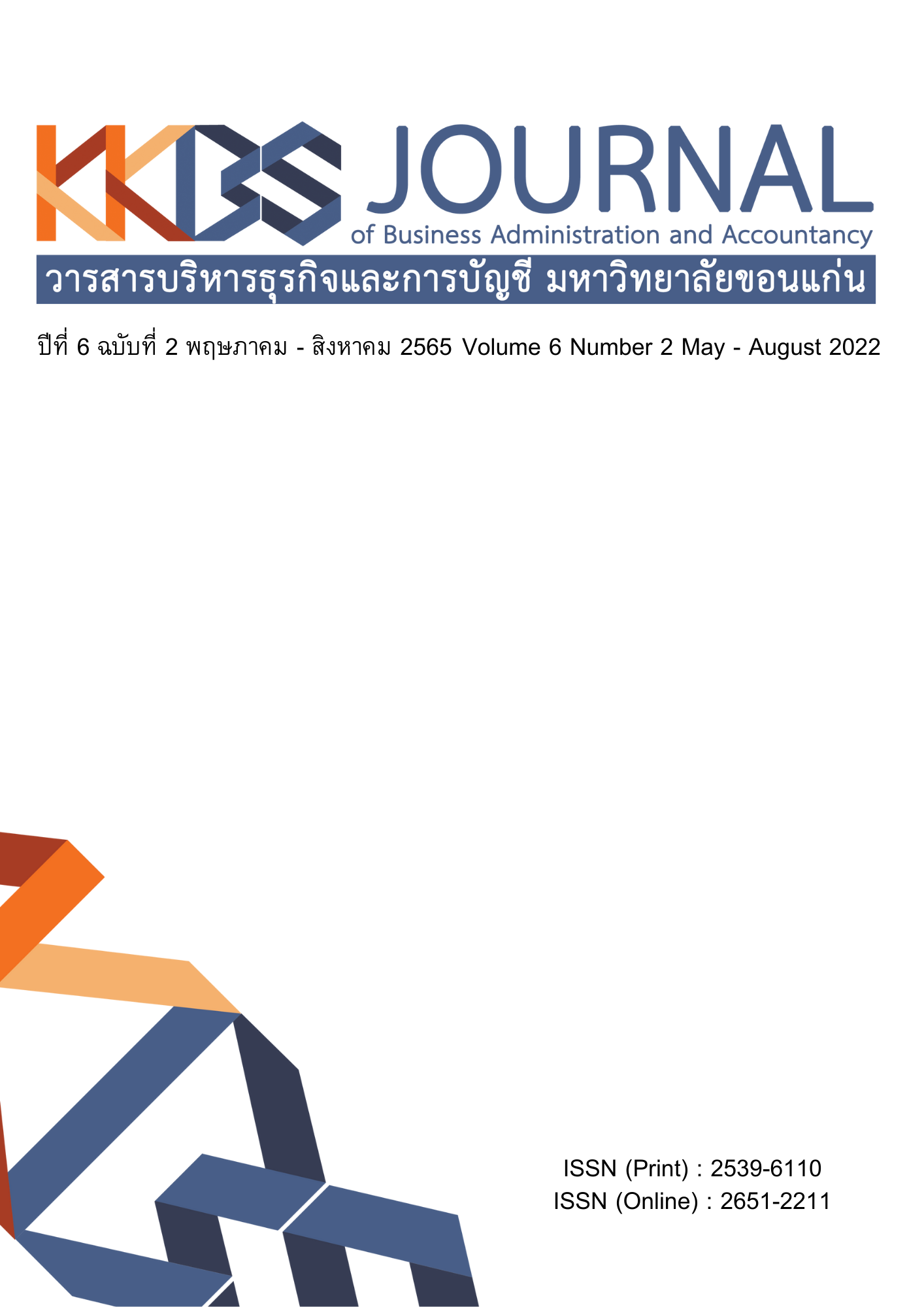ปัจจัยที่ส่งผลต่อผลการปฏิบัติงานและความตั้งใจในการลาออกของพนักงาน กรณีศึกษา: ในกลุ่มพนักงานวิศวกรเจเนอเรชั่น Y ในเขตกรุงเทพมหานคร
Main Article Content
บทคัดย่อ
การวิจัยนี้มีวัตถุประสงค์เพื่อศึกษาและวิเคราะห์ปัจจัยที่ส่งผลต่อผลการปฏิบัติงาน และปัจจัยที่ส่งผลต่อการตัดสินใจลาออกของกลุ่มพนักงานวิศวกรที่อยู่ในช่วง เจเนอเรชั่น Y เนื่องจากในปัจจุบันกลุ่มคนเหล่านี้เป็นกำลังแรงงาน และมีบทบาทที่สำคัญในองค์กรมากขึ้น เพื่อให้เกิดประโยชน์สูงสุด องค์กรต้องปรับตัวโดยการใช้โอกาสจากคุณลักษณะเด่นของพนักงานกลุ่มนี้ เช่น ความเป็นตัวของตัวเองความเชื่อมั่นในตัวเอง และความสามารถในการปรับตัว แต่อย่างไรก็ตามด้วยคุณสมบัติดังกล่าว ทำให้คนกลุ่มนี้ไม่ยึดติดกับองค์กรและมีโอกาสลาออกสูงกว่าเจเนอเรชั่นอื่น ๆ ดังนั้นงานวิจัยชิ้นนี้จึงทำการสำรวจพนักงงานวิศวกร ที่เกิดระหว่างปี พ.ศ. 2523-2543 จำนวน 400 คน โดยการใช้แบบสอบถามในการเก็บข้อมูล และวิเคราะห์ข้อมูลโดยใช้สมการโครงสร้าง (Structural Equation Modeling) เพื่อหาความสัมพันธ์ของตัวแปรที่ส่งผลต่อผลการปฏิบัติงานและความตั้งใจในการลาออก ผลการศึกษาพบว่า ปัจจัยที่ส่งผลทางบวกโดยตรงต่อผลการปฏิบัติงานของพนักงาน ได้แก่ ความสัมพันธ์กับเพื่อนร่วมงาน โอกาสในการเจริญก้าวหน้าในการทำงาน และผลตอบแทน ส่วนปัจจัยที่ส่งผลทางลบโดยตรงต่อผลความตั้งใจในการลาออกของพนักงาน ได้แก่ โอกาสในการเจริญก้าวหน้าในการทำงาน ค่าตอบแทน และ การสนับสนุนจากหัวหน้างาน แต่เมื่อวิเคราะห์โดยใช้ผลการปฏิบัติงานเป็นตัวแปรส่งผ่าน (Partial mediation) จะพบว่าไม่มีผลเป็นตัวแปรส่งผ่านทางอ้อมระหว่างปัจจัยกระตุ้นต่าง ๆ และความตั้งใจในการลาออก โดยข้อมูลที่ได้จะเป็นประโยชน์ต่อบริษัทต่าง ๆ เพื่อจัดการวางแผนนโยบายในการสร้างแรงจูงใจให้พนักงานทำงานอย่างมีประสิทธิผลมากขึ้น และนำไปสู่การรักษาพนักงานที่มีคุณภาพให้อยู่กับองค์กร
Article Details

อนุญาตภายใต้เงื่อนไข Creative Commons Attribution-NonCommercial-NoDerivatives 4.0 International License.
บทความที่ได้รับการตีพิมพ์ในวารสารเป็นความคิดเห็นของผู้เขียน มิใช่ความคิดเห็นของกองบรรณาธิการและคณะผู้จัดทำวารสาร และบทความที่ได้รับการตีพิมพ์เป็นลิขสิทธิ์ของวารสารบริหารธุรกิจและการบัญชี มหาวิทยาลัยขอนแก่น
เอกสารอ้างอิง
Alkhateri, A.S. et al. (2018). The impact of perceived supervisor support on employee’s turnover intention: The mediating role of job satisfaction and affective organizational commitment. International Business Management, 12(7), 477-492.
Arnold, H.J. & Feldman, D.C. (1982). A multivariate analysis of the determinants of job turnover. Journal of applied psychology, 67(3), 350-360.
Bluedorn, A.C. (1982). A unified model of turnover from organizations. Human relations, 35(2), 135-153.
Byrne, B.M. (2010). Structural equation modeling with AMOS: Basic concepts, applications, and programming. 2nd ed. New York: Routledge.
Boonyapo, K. (2019). Motivation building of staffs for satisfaction in organization. Nakhon Lampang Buddihist College's Journal, 8(1), 237-251. (In Thai)
De Simone, S., Planta, A. & Cicotto, G. (2018). The role of job satisfaction, work engagement, self-efficacy and agentic capacities on nurses' turnover intention and patient satisfaction. Applied Nursing Research, 39, 130-140.
Gefen, D., Rigdon, E. & Straub, D. (2011). An update and extension to SEM guidelines for administrative and social science research. Editorial comment. MIS Quarterly, 35(2), 1-7.
Hackman, J.R. & Lawler, E.E. (1971). Employee reactions to job characteristics. Journal of applied psychology, 55(3), 259-286.
Hair, J.F. et al. (2010). Multivariate data analysis: a global perspective. 7th ed. Upper Saddle River, NJ.: Pearson.
Huahongthong, P., Kerdvichai, N. & Suyaprom, S. (2019). Integration of buddhist principles for development of the working life quality of officer in department of disaster prevention and mitigation, Ministry of Interior. Journal of Graduate MCU Khon Kaen Campus, 6(3), 229-247. (In Thai)
Johnston, N. & Spinks, W. (2013). Organisational climate and employee turnover intention within a franchise system. The Journal of New Business Ideas & Trends, 11(1), 20-41.
Junrodjana, S. & Chienwattanasook, K. (2020). Quality of work life and work environment affecting organizational commitment of employee. Journal of Social Science and Buddhistic Anthropology, 5(4), 160-174. (In Thai)
Kalidass, A. & Bahron, A. (2015). The relationship between perceived supervisor support, perceived organizational support, organizational commitment and employee turnover intention. International Journal of Business Administration, 6(5), 82-102.
Kawchaisa, N., Hemrungrojn, S. & Buathong, N. (2018). Work happiness and organizational commitment in the import and distribution company. Chula Med Journal, 62(6), 987-999. (In Thai)
Kim, H., Knight, D.K. & Crutsinger, C. (2009). Generation Y employees' retail work experience: The mediating effect of job characteristics. Journal of business research, 62(5), 548-556.
Kim, H. & Stoner, M. (2008). Burnout and turnover intention among social workers: Effects of role stress, job autonomy and social support. Administration in Social work, 32(3), 5-25.
Kline, R.B. (2011). Principles and practice of structural equation modelling. 3rd ed. New York: Guilford Press.
Klonoski, R. (2016). Defining employee benefits: A managerial perspective. International Journal of Human Resource Studies, 6(2), 52-72.
Konjanart, P. (2015). Characteristics of engineers in the views of the automotive and the auto parts industries. Journal of Rangsit Graduate Studies in Business and Social Sciences, 1(1), 147-159. (In Thai)
Kraisuth, D. & Panjakajornsak, V. (2018). Thai AEC engineer readiness: A confirmatory factor analysis. SAGE Open, 8(1), DOI: 2158244017745346.
Lu, L. et al. (2016). Work engagement, job satisfaction, and turnover intentions. International journal of contemporary hospitality management, 28(4), 737-761.
Mowday, R.T., Porter, L.W. & Steers, R.M. (1982). Employee-organization linkages. New York: Academic Press.
Nunnally, J. & Bernstein, I.H. (1994). Psychometric theory. New York: McGraw-Hill.
Orawongsuphathat, C. & Pimthong, S. (2018). Causal relationship of organizational loyalty of gen Y engineer in Thai telecommunication public enterprise. Journal of Industrial Education, 17(1), 120-128. (In Thai).
Phanthet, K. & Chaikidurajai, P. (2019). Organizational culture and quality of work life affecting organizational citizenship behavior and performance efficiency of one of government banks’ officers. Academic Services Journal, 30(1), 53-65.
Phatchaya, S. (2017). Changes in operating conditions with the resignation of Japanese interpreters in Japanese companies, northern region industrial estate, Lamphun province. JSN Journal, 7(3), 172-185. (In Thai)
Pigors, P.J.W., Myers, C.A. & Malm, F. (1973). Management of human resources: Readings in personnel administration. New York: McGraw-Hill.
Price, J.L. (1977). The study of turnover. Iowa: Iowa State University Press.
Queiri, A., Yusoff, W.F.W. & Dwaikat, N. (2014). Generation-Y employees' turnover: Work values fit perspective. International journal of business and management, 9(11), 199-213.
Randhawa, G. (2007). Work performance and its correlates: An empirical study. Vision The Journal of Business Perspective, 11(1), 47-55.
Rubel, M.R.B. & Kee, D.M.H. (2015). High commitment compensation practices and employee turnover intention: Mediating role of job satisfaction. Mediterranean Journal of Social Sciences, 6(6), 321-321.
Suliman, A.M. (2001). Work performance: is it one thing or many things? The multidimensionality of performance in a Middle Eastern context. International Journal of Human Resource Management, 12(6), 1049-1061.
Tabachnick, B.G. & Fidell, L.S. (2007). Using multivariate statistics. 5th ed. Boston: Pearson.
Tongsan, N. (2014). Factors effecting work efficiency of employees in cosmetics manufacturing business in Pathumthani. Pathumthani: Rajamangala University of Technology Thanyaburi. (In Thai)
Wan, Q. et al. (2018). Effects of work environment and job characteristics on the turnover intention of experienced nurses: The mediating role of work engagement. Journal of Advanced Nursing, 74(6), 1332-1341.


